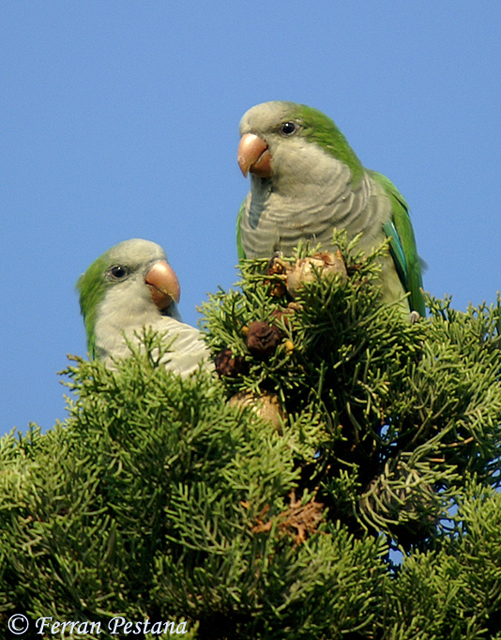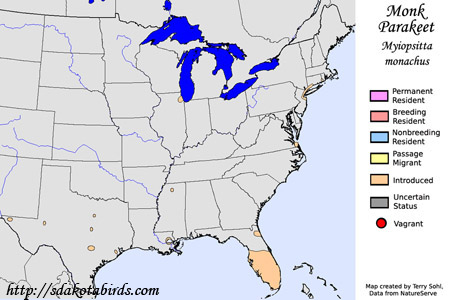| Length: 11.5 inches | Wingspan: 19 inches | Seasonality: Non-resident in South Dakota |
| ID Keys: Bright green upperparts, pale gray forehead and breast, lighter yellowish-green belly | ||
 The
native range of the Monk Parakeet covers large parts of South America.
However, they have been introduced in many areas of the United States, with
populations found in New England, Florida, Portland (Oregon), Texas,
Chicago, and many other scattered locations. They first became noticed
as an invasive species in the late 1960s, when birds were first documented
breeding in Florida, and when a number of birds escaped from damaged crates
at JFK Airport in New York City. Other escapees, and perhaps
intentional releases, have occurred in many other areas. They were once
considered a potential threat to agriculture in the U.S., but the threat has
yet to materialize, as populations have never spread widely into rural
areas. They feed heavily on fruits and berries, and are most common in
areas with access to such food items, such as in Florida. They are
often found in urban settings due to the planting of exotic, flowering and
fruiting plants. While a South American species, they are naturally
found in some mountainous areas where temperatures may get relatively cold,
and thus they have adapted fairly well to some colder climate areas of the
United States.
The
native range of the Monk Parakeet covers large parts of South America.
However, they have been introduced in many areas of the United States, with
populations found in New England, Florida, Portland (Oregon), Texas,
Chicago, and many other scattered locations. They first became noticed
as an invasive species in the late 1960s, when birds were first documented
breeding in Florida, and when a number of birds escaped from damaged crates
at JFK Airport in New York City. Other escapees, and perhaps
intentional releases, have occurred in many other areas. They were once
considered a potential threat to agriculture in the U.S., but the threat has
yet to materialize, as populations have never spread widely into rural
areas. They feed heavily on fruits and berries, and are most common in
areas with access to such food items, such as in Florida. They are
often found in urban settings due to the planting of exotic, flowering and
fruiting plants. While a South American species, they are naturally
found in some mountainous areas where temperatures may get relatively cold,
and thus they have adapted fairly well to some colder climate areas of the
United States.
They are still considered pests in some areas, but the issue isn't their threat as an agricultural pest, but is the unique, large bulky stick nests that they build. Most parakeet species nest in burrows, but Monk Parakeets build very large nest structures that are used for both nesting, as well as for roosting at night. In the U.S., they often choose to build their nests on utility poles, where they have caused issues with electrical transmission. As such, in some areas there have been culls of the birds, despite what is often a local outcry against such culls.
Habitat: Found in open woodlands, agricultural areas, and some suburban areas in their native range. In the U.S., most populations are currently found around suburban settings and parks, where they may take advantage of exotic fruiting shrubs and trees planted for landscaping.
Diet: Feeds on a variety of plant material, including flowers, seeds, berries, fruits, and buds of plants. They will also sometimes feed on insects. As noted above, they are considered an agricultural pest in South America, where they will feed on grain products in agricultural fields. That has yet to become much of an issue in the United States.
Behavior: Uses a variety of foraging techniques, often walking on the ground or moving deliberately through vegetation in search of food. Often forages in flocks, where individual "spotter" birds may perch higher above the feeding birds, warning the group of potential threats.
Nesting: The nest of a Monk Parakeet is unique compared to most parakeets, who nest in cavities in trees. The Monk Parakeet builds a very large, bulky nest of sticks.
Song: The voice of a Monk Parakeet is a rattling series of variable notes that rises in pitch. Also has other vocalizations.
Migration: Considered a permanent resident throughout their native range in South America. In the U.S., populations are also considered permanent, with no noticeable migration.
Interactive eBird map: Click here to access an interactive eBird map of Monk Parakeet sightings
Feeders: The Monk Parakeet has become accustomed to visiting bird feeders for various seeds, fruits, and nuts.
Similar Species: Not likely to be confused with any native, extant U.S. species. Of species that have been introduced in some locations in the U.S., most likely to be confused with the Green Parakeet, White-winged Parakeet, Yellow-Chevroned Parakeet, or Thick-billed Parakeet, although plumage differences are obvious if seen well.
Conservation Status: Populations of Monk Parakeet appear to be increasing in many areas of the globe, and they appear to be relatively stable in many parts of the U.S. where they have been introduced. The IUCN lists the Monk Parakeet as a species of "Least Concern".
Further Information: 1) Florida Fish and Wildlife Conservation Committee - Monk Parakeet
2) WhatBird - Monk Parakeet
3) Audubon Guide - Monk Parakeet
Photo Information: Photo taken by Ferran Pestana - Photo licensed under Creative Commons Attribution ShareAlike 2.0 Generic License.
| Click below for a higher-resolution map |
 |
| South Dakota Status: Non-resident in South Dakota |
Additional Monk Parakeet Photos (coming soon!!)
